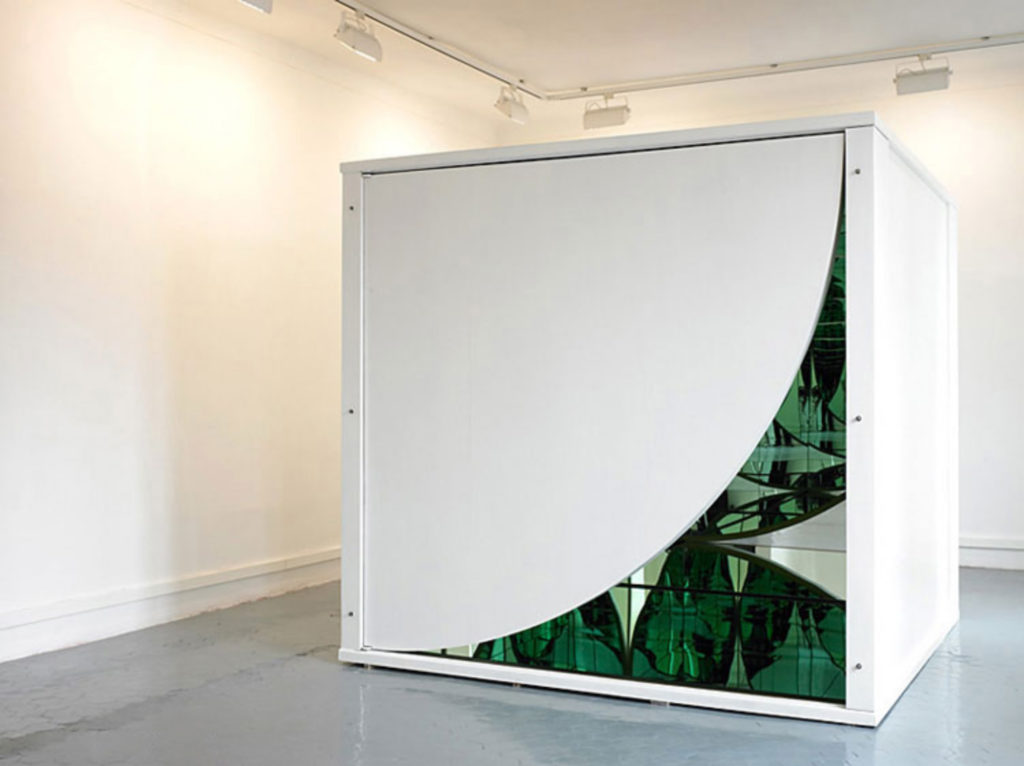What Do We Do About Reality?
by Enrico Pedrini

As when looking into a mirror
The shape and its reflection stare at each other
You are not the reflection
But the reflection is you
–Hokyo Zan Mai, Poem X
Nadine Spinoza’s White Cube, on display at the Depardieu gallery in Nice, is a small box room covered inside by mirrors. A quarter circle cut out from the bottom right hand corner invites the viewer inside, to step beyond the limits of reality towards new virtual realities, where space and volumes are multiplied and expanded to infinity. Spinoza recreates what W. Heisenberg describes in his book Physics and Philosophy as, “…not nature itself, but nature as it is exposed to our method of investigation.”
Enrico Pedrini: What are the motivations that led you to make White Cube?
Nadine Spinoza: What brought me to this work is a reflection on time–the way we perceive time as a continuous line with a beginning and an end. It is because we physically feel time in this way, that we also measure it simply. Maybe this is not the way it is. But we only consider this linear aspect of time, and we measure everything around us–the whole universe–based on this rule. And when you talk about Time, you are also talking about Light, and about the speed of Light. You are talking about seeing… It’s an epistemological issue.
EP: What happens when you enter the White Cube?
NS: The Oriental way of thinking consists of turning around the object that’s being contemplated. A multidimensional impression stems from the superimposition of singular impressions corresponding to different viewpoints, as Lama Anagarika Govinda posits in “Logic and Symbol,” regarding a multidimensional conception of the universe. This is precisely what happens when you find yourself inside the cube. You can see yourself from different angles simultaneously, to infinity. Blind spots are removed. Who is watching who? The Western Cartesian conception of the world in three dimensions is materialized by the edges of the cube. These edges recall the familiar notions of space and time. After the first few minutes, you feel as though you’re outside your own body and everywhere at once.
EP: Because of the general irreversibility of technological innovation, the evolution of knowledge is encouraging us to go beyond the simple use of language as a tool of analysis for practical action. Images are becoming a more important language. I now wonder whether your White Cube is involved in this process?
NS: Yes, it seems that we are reaching a point of no return, what has been termed “the final act of irreversibility.” Faced with this void and with the loss of meaning, we must thoroughly reassess all our categories and practices. It even seems that we are on the verge of a mutation of anthropological nature. We must re-invent and rethink the world, not just the world of art. We must reinvent all these “familiar” notions of time, duration, and space, starting with the notion of reality. What do we know about reality?
The most recent discoveries in astrophysics teach us that the matter from which we are made, summarized through the notion of atoms, is only the visible superficial pelicula of matter–its expressive luminescent forefront. The universe is only four percent ordinary matter, the stuff of stars and trees and people. Twenty-three percent is exotic matter: dark mass that astrophysicists believe is made up of as yet undetected particles. And the remainder, 73 percent, is dark energy. We know nothing at present about dark energy, and we therefore cannot discuss it save to say that it exists.
Our perception of a three-dimensional universe may just be an “extraordinary illusion,” since this perception is just our brain’s fabrication based on a two-dimensional image transmitted from the retina. The laws of perspective have more to teach us about our visual apparatus and its characteristics than about reality. To infinity, and in all directions, what we observe in a last analysis is “ourselves”–our thoughts, our ability to elaborate concepts, to draw hypotheses.
Now, if you add to this the staggering proliferation of means of communication and images, here we are: all conditions are set to tear up reality. Each one of us can, potentially, communicate with the whole planet. Instantly. And each one of us can create, archive and have access to billions of data items, images and sounds… In the face of such a cacophony, each one of us has to determine what makes sense for him/her, and which type of connections he/she wishes to establish with others. Each one of us, and not only artists, creates his/her own universe. This has always been the case. We have only just become conscious of this. What solution is left when we understand that the world is not “real,” but that we are the world? Start by inventing yourself. Then try to establish new, perhaps yet unattempted, connections. The easiest way in which these notions may become accessible, is the creation of a cube using mirrors for its six inner sides. One of the sides is a quarter-circle. Therefore, the cube is always “open.” Come into the cube. Experience this for yourself.